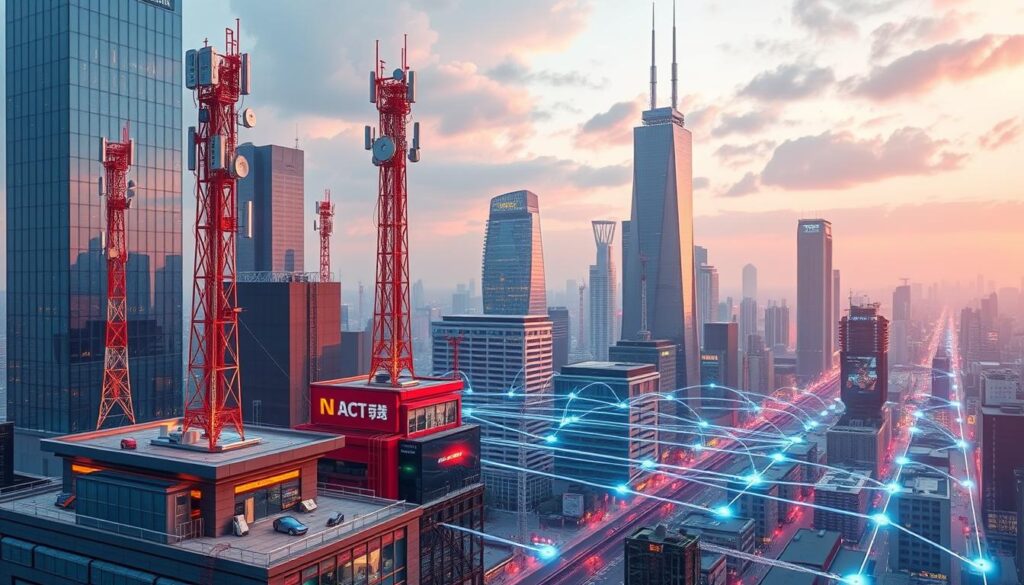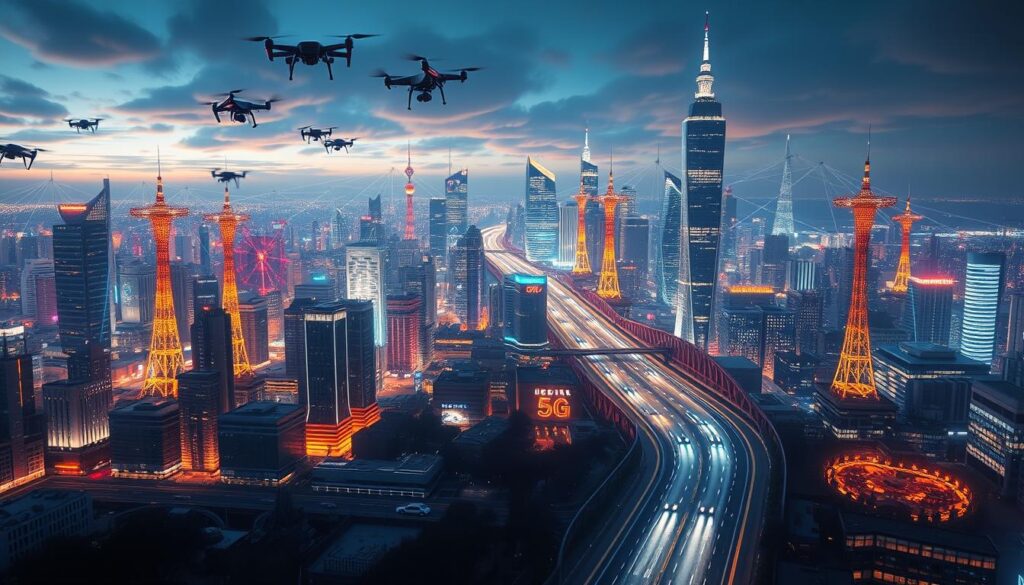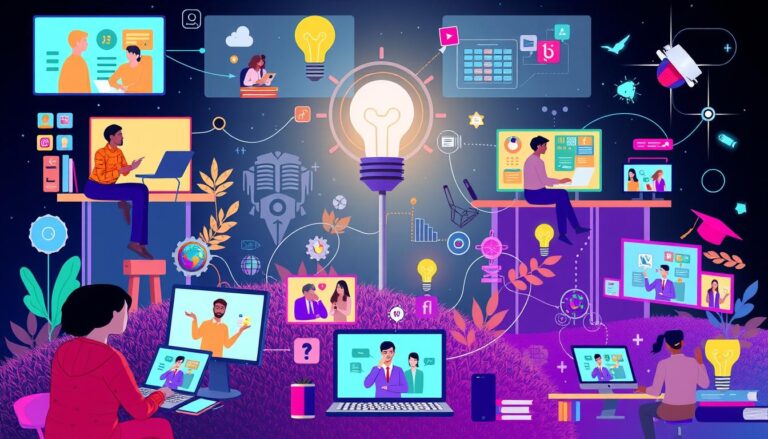5G Technology: The Future of Connectivity
The world of wireless communication is changing fast with 5G technology. This next-generation network is set to change how we connect and use digital tools. Now, 62% of smartphones have 5G, bringing us faster and more reliable connections.
5G was created by the 3rd Generation Partnership Project. It’s more than just an upgrade. It’s a new way of thinking about mobile networks, affecting everything from personal gadgets to big industrial systems. Big names like Verizon, T-Mobile, and AT&T are quickly growing their 5G networks. They now cover over 7,500 cities in the US.
5G is not just about faster downloads. It’s going to change many industries and help create smart cities. It will also make remote work, healthcare, and manufacturing better. As networks get better, we’ll see even more cool uses of 5G.
Table of Contents
Understanding 5G Network Architecture
The 5G network architecture is a big change in how we connect online. It’s different from older systems because it’s more flexible and fast. This makes it great for today’s tech needs.

Radio Access Network Components
The Radio Access Network (RAN) connects phones to the internet. It has important features like:
- Smaller, more efficient transmitters
- Reduced power consumption
- Enhanced signal coverage
- Support for millimeter-wave frequencies
Core Network Infrastructure
The core network of 5G is a big improvement. It has a new design that makes the network better. This includes:
- Faster data processing
- Reduced latency (as low as 1 millisecond)
- Increased network efficiency
- Advanced edge computing capabilities
Network Slicing Technology
Network slicing is a new idea in 5G. It lets telecom companies make many virtual networks on one physical one. This offers:
- Customized service delivery
- Enhanced security protocols
- Improved resource allocation
- Flexible enterprise solutions
“5G network slicing transforms infrastructure from a one-size-fits-all model to a dynamic, adaptable communication ecosystem.” – Telecom Innovation Research
With these advanced parts, 5G networks can handle billions of connected devices. They do it fast, reliably, and efficiently.
The Evolution from 4G to 5G Technology

The move from 4G to 5G is a major leap in internet and wireless tech. It brings new abilities that change how we use digital networks.
Here are the main differences between 4G and 5G:
- Dramatically increased data transmission speeds
- Reduced network latency
- Enhanced device connectivity
- More efficient spectrum utilization
5G introduces new network tech that boosts wireless communication. It supports different radio frequency bands for better and more flexible connections:
| Frequency Band | Characteristics | Performance Impact |
|---|---|---|
| Low-band | Less than 1 GHz | Wider coverage |
| Mid-band | 1 GHz–6 GHz | Balanced speed and range |
| High-band | 24 GHz–40 GHz | Ultra-fast speeds |
“5G is not just an upgrade; it’s a technological revolution that will transform how we live, work, and communicate.” – Wireless Technology Expert
The shift brings unprecedented network capabilities. Think about downloading movies in seconds or having smooth video calls. 5G makes these things possible by supporting a lot of devices and cutting down on delays.
By 2025, over two billion 5G connections are expected worldwide. This is a big step forward in wireless tech.
Key Features and Capabilities of 5G Networks
5G technology is a big step forward in wireless communication. It offers new features that will change how we use technology. These networks are designed to meet our growing digital needs.
Enhanced Mobile Broadband
Enhanced Mobile Broadband (eMBB) brings fast data speeds. It’s up to 20 Gbps, which is much faster than 4G LTE. This means you can download movies quickly and stream without interruptions.
Ultra-Reliable Low Latency Communication
Low latency communication is a big deal with 5G. It has latency as low as 1 millisecond. This is great for things like:
- Autonomous vehicle control
- Remote surgical procedures
- Virtual reality experiences
- Industrial automation
Massive Machine Type Communications
IoT connectivity gets a boost with 5G. It can connect up to 1 million devices per square kilometer. This supports complex IoT systems in cities, industries, and homes.
| 5G Capability | Key Performance Metrics |
|---|---|
| Speed | Up to 20 Gbps |
| Device Density | 1 million devices/km² |
| Latency | 1 millisecond |
| Power Efficiency | Up to 90% reduction |
“5G is not just an upgrade—it’s a technological revolution that will redefine connectivity.” – Wireless Technology Expert
These features make 5G a key part of future tech. It will help us have smarter, faster, and more responsive digital experiences in many areas.
Current 5G Deployment Status Worldwide
The world is seeing a big change with 5G technology. By 2024, almost two billion people will use 5G. This is a big step forward for how we connect.
How 5G is being used around the world is different:
- United States: Over 75% of subscribers have access to 5G services
- China: Over 1.2 million 5G base stations with 600 million subscribers
- South Korea: 90% of mobile users connected to 5G networks
- United Arab Emirates: 80% population coverage
More money is being spent on 5G every year. By 2025, it’s expected to be around $600 to $650 billion. The U.S. wants to spend $65 billion to help rural areas get better internet.
“5G is not just an upgrade; it’s a technological revolution transforming how we connect and communicate.” – Telecommunications Industry Expert
Even with big steps forward, there are still problems. Low- and middle-income countries face issues with getting 5G online. They also struggle with making it affordable and getting people to use it.
The 5G Connectivity Index shows that some countries are ahead. Places like the Gulf, Scandinavia, and Asia Pacific are leading. Now, people can download things at speeds of about 230 Mbps on 5G. This is much faster than before.
5G Technology Impact on Industries
5G is changing industries with its advanced IoT connectivity and edge computing. This new tech is making businesses rethink how they work, talk, and innovate in many fields.
5G’s fast and reliable networks open up new chances for industries to update their tech. It can move data at up to 10 gigabits per second. It also supports one million devices per square kilometer. This is leading to a big digital change.
Healthcare Applications
In healthcare, 5G is making big steps forward in patient care and medical tech:
- Remote patient monitoring with real-time data
- Telemedicine with ultra-low latency
- Surgical robots with millisecond responses
- Improved medical imaging and diagnostics
Manufacturing and Industry 4.0
5G is changing manufacturing with its advanced IoT and edge computing:
| Technology | 5G Impact |
|---|---|
| Autonomous Robots | Precision operations with real-time sync |
| Predictive Maintenance | Instant sensor data analysis for proactive management |
| Remote Monitoring | Advanced control in hazardous environments |
Smart Cities Development
5G powers smart city infrastructure with smart IoT connectivity:
- Traffic management with real-time sensors
- Air quality monitoring and environmental tracking
- Energy grid optimization
- Public safety and emergency response systems
“5G is not just a network upgrade, but a fundamental platform for technological innovation across industries.” – Tech Innovation Research Institute
By 2035, 5G is expected to create $13.2 trillion in global economic output. It will also create 22.3 million jobs worldwide. This will change how businesses use connectivity and computational power.
Fixed Wireless Access and Home Connectivity
Fixed Wireless Access (FWA) is changing how we get high-speed internet at home and in businesses. It’s a new way to connect communities, especially where it’s hard to lay down cables.
The main benefits of FWA are:
- It can be set up in weeks, not months
- It’s cheaper than fiber optic cables
- It offers speeds as fast as wired connections
- It works well in many different places
“FWA represents a game-changing approach to broadband connectivity, bringing internet access to previously underserved communities.”
5G FWA brings big advantages for everyone. Small businesses can use it as their main internet. Big companies use it as a backup when their network goes down.
| FWA Performance Metrics | Specifications |
|---|---|
| Average Download Speed | 100-300 Mbps |
| Deployment Time | Days |
| Global Subscription Projection by 2029 | 265 million |
| Setup Complexity | Plug-and-Play |
The future of FWA is bright, with more people expected to use it. Wireless communication technologies continue to transform how we connect and communicate. This makes high-speed internet more available than ever.
Private 5G Networks for Enterprise Solutions
Private 5G networks are changing how businesses connect. They give companies control over their network. This means better security, performance, and the ability to slice their network.
Security Benefits
Private 5G networks offer big security wins for businesses. They create safe spaces for data, keeping it away from hackers. Key benefits include:
- Dedicated bandwidth with less interference
- Strong access controls
- Easy network management
- Better data privacy
Implementation Strategies
Setting up a private 5G network needs a solid plan. Companies have two main options:
- Own and manage the network fully
- Use network slicing from public 5G providers
“Private 5G networks are the backbone of digital transformation initiatives in modern enterprises.”
Cost Considerations
Starting a private 5G network costs a lot upfront. But, the long-term gains are worth it. Adding edge computing and optimizing the network can bring big returns.
| Investment Area | Estimated Cost Range | Strategic Value |
|---|---|---|
| Network Infrastructure | $500,000 – $2,000,000 | High performance, secure connectivity |
| Edge Computing Integration | $250,000 – $750,000 | Enhanced data processing capabilities |
| Annual Maintenance | $100,000 – $500,000 | Continuous network optimization |
With private 5G networks, your business can reach new heights. You’ll see better efficiency, security, and innovation.
Edge Computing and 5G Integration
The mix of edge computing and 5G is changing how companies handle and analyze data. It brings computation closer to where data is made, leading to fast communication and IoT connections in many fields.
Edge computing changes how data is processed by cutting down on distance and network jams. With 5G, companies can analyze data almost instantly. This opens up big chances for making quick decisions.
“Edge computing combined with 5G is revolutionizing technological infrastructure across global industries.” – Tech Innovation Research
- Reduces data transmission latency
- Enhances IoT device performance
- Enables advanced real-time analytics
- Improves network security
This tech combo has a big economic effect. Spending on edge computing and 5G has jumped by 35% in a year. This shows a big investment by the industry.
| Industry | Efficiency Improvement | Key Benefit |
|---|---|---|
| Manufacturing | 40% | Operational Performance |
| Healthcare | 50% | Response Time Reduction |
| Automotive | 15% | Productivity Enhancement |
For companies looking to get ahead, using edge computing with 5G offers great chances. It helps improve operations, boost IoT connections, and use fast communication tech.
5G Infrastructure Investment and Market Growth
The world of 5G technology is growing fast, with huge investments changing cellular networks everywhere. Market analysis shows great chances for building and growing infrastructure.
Investment trends in 5G infrastructure are very promising:
- Global market size expected to reach $62.10 billion by 2033
- Projected compound annual growth rate (CAGR) of 14.90%
- Big growth in many regions
“5G infrastructure represents the backbone of next-generation digital connectivity” – Technology Research Insights
There are big differences in 5G investments around the world:
- Asia-Pacific leads with a 35.50% market share
- Europe is growing the fastest at 49.6% CAGR
- The United States market is estimated at $6.2 billion in 2023
Big telecom companies are leading the way with huge investments. Leaders like Ericsson, Nokia, Samsung, and Huawei are key in making advanced 5G networks.
The need for more data and better network capacity is driving 5G investments. Expect big changes as these networks get better and spread out more.
Challenges and Future Development
The journey of 5G technology is filled with big challenges. These challenges test the limits of telecommunications innovation. Understanding these obstacles is key to unlocking 5G’s full potential.
Spectrum Allocation Complexities
Spectrum allocation is a big challenge for 5G. The mmWave spectrum offers both opportunities and challenges for network operators. Key issues include:
- Limited availability of high-frequency bandwidths
- Regulatory hurdles in spectrum management
- Competing interests between federal and commercial users
“Spectrum is a finite resource, with different frequency bands offering unique trade-offs between coverage and capacity.” – Telecommunications Expert
Infrastructure Investment Challenges
Deploying 5G networks requires a lot of money. The costs for infrastructure, especially for mmWave spectrum, are high. Experts say that:
- Billion-dollar investments are necessary for comprehensive network rollout
- Dense small cell deployments are essential for optimal coverage
- Specialized equipment increases overall infrastructure expenses
Technical Limitations to Overcome
5G technology faces several technical constraints. Signal propagation issues with high-frequency mmWave spectrum demand new solutions. More base stations are needed for good coverage and network reliability.
Despite these challenges, 5G’s potential is huge. By 2035, 5G is expected to create $13.2 trillion in global economic value. This shows the powerful impact of this technology.
Conclusion
Exploring next-generation wireless technology, 5G is a game-changer. It’s not just about faster downloads. It’s about changing how we live and work. With speeds up to 20 Gbps and latency as low as 1-2 milliseconds, it’s a huge leap forward.
The effects of 5G are huge and far-reaching. By 2029, 5.6 billion subscriptions will make up 60% of mobile networks worldwide. It’s changing healthcare, smart cities, and more. The U.S. is leading with 31.1% 5G availability.
5G is more than an upgrade. It’s a new way of connecting. It supports 1 million devices per square kilometer and uses less energy. As it grows, expect even more amazing uses in our daily lives.







